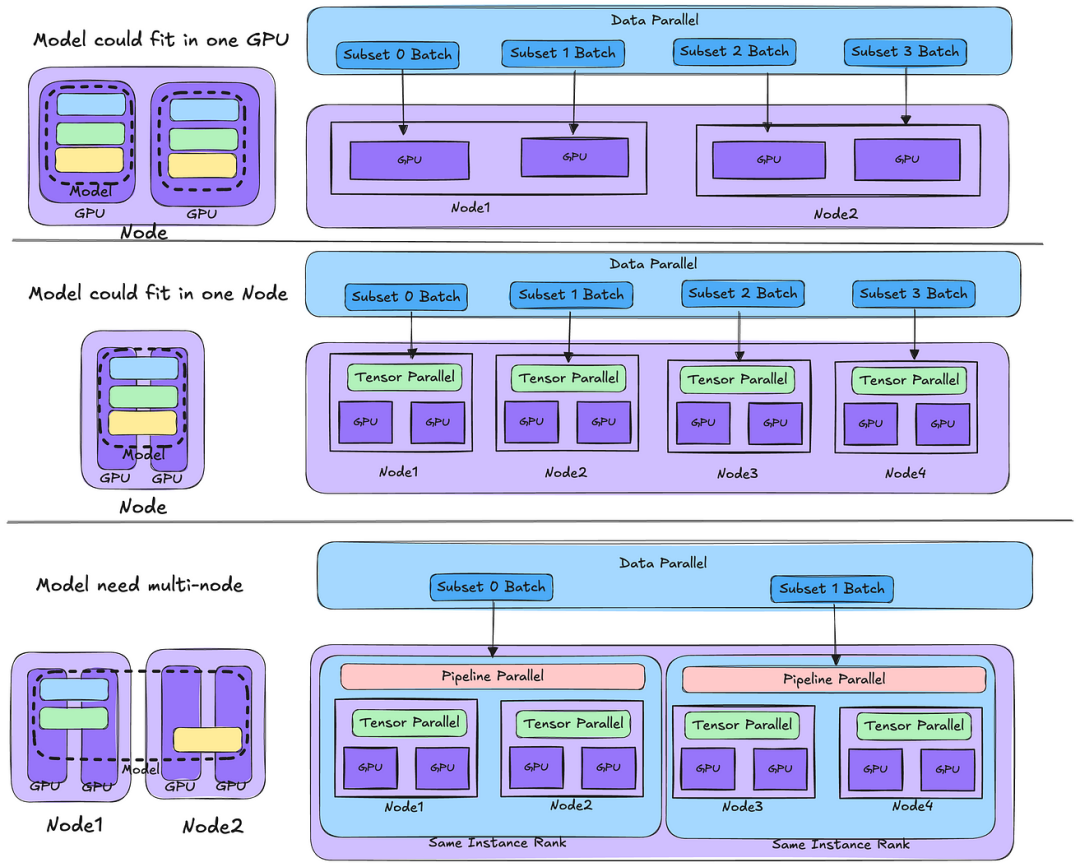从FasterTransformer源码解读开始了解大模型(2.4)代码解读05-ContextDecoder的前向01
写在前面的话
ContextDecoder部分是用于处理输入部分的组件层,在这一层中,会对所有输入的input ids进行处理,计算Attention(在此过程中还会生成KV Cache),计算FFN,在完成所有输入部分计算之后,会生成输出部分的第一个token
零、ContextDecoder的buffer和功能函数
在src/fastertransformer/models/multi_gpu_gpt/ParallelGptContextDecoder.cc这个文件中包含了整个gpt的ContextDecoder的函数和组成结构。从25到85行的initial函数中,可以初步看见整个ContextDecoder的整体结构:
template<typename T>
void ParallelGptContextDecoder<T>::initialize()
{
FT_LOG_DEBUG(__PRETTY_FUNCTION__);
self_attention_layer_ = new TensorParallelGptContextAttentionLayer<T>(max_batch_size_,
max_seq_len_,
head_num_,
size_per_head_,
tensor_para_,
stream_,
cublas_wrapper_,
allocator_,
true,
is_free_buffer_after_forward_,
is_qk_buf_float_,
sparse_,
int8_mode_,
custom_all_reduce_comm_,
enable_custom_all_reduce_);
bool use_gated_activation = activation_type_ == ActivationType::GeGLU || activation_type_ == ActivationType::ReGLU;
size_t max_inter_size = has_adapters_ ? std::max(inter_size_, adapter_inter_size_) : inter_size_;
if (activation_type_ == ActivationType::Gelu || activation_type_ == ActivationType::GeGLU) {
ffn_layer_ = new TensorParallelGeluFfnLayer<T>(max_batch_size_,
max_seq_len_,
head_num_,
size_per_head_,
expert_num_, // expert_num
max_inter_size,
tensor_para_,
stream_,
cublas_wrapper_,
allocator_,
true,
is_free_buffer_after_forward_,
sparse_,
int8_mode_,
use_gated_activation,
custom_all_reduce_comm_,
enable_custom_all_reduce_);
}
else if (activation_type_ == ActivationType::Relu || activation_type_ == ActivationType::ReGLU) {
ffn_layer_ = new TensorParallelReluFfnLayer<T>(max_batch_size_,
max_seq_len_,
head_num_,
size_per_head_,
expert_num_, // expert_num
max_inter_size,
tensor_para_,
stream_,
cublas_wrapper_,
allocator_,
true,
is_free_buffer_after_forward_,
sparse_,
int8_mode_,
use_gated_activation,
custom_all_reduce_comm_,
enable_custom_all_reduce_);
}
}
主要由一个Attention层和一个ffn层组成,Attention层主要负责进行注意力得分计算,而FFN层则主要负责进行矩阵乘进行升降维,并在高维时进行激活。在initial函数中,由于根据模型配置可能会调用不同的激活函数,所以这里留了不同激活函数的FFN。
在93到147行,则是对ContextDecoder中用到的buffer进行专门的分配。其中一些buffer可以从变量名看出它的具体用途,比如decoder_normed_input,用于存储归一化后的input输入,normed_self_attn_output用于存储归一化后的attention模块输出。而149到183,则是对上面allocate后的buffer进行释放的freebuffer函数。
在185到212行,是一系列用于layer id判断的函数。为什么要这么做?我们之前有介绍过PP架构,即Pipeline Parallel流水线并行,会将一个完整模型的多个层划分给不同的机器节点(假设我们这里有一个80层的llama2-70b,那么我们可以考虑部署4台gpu机器,每个机器负责20层,这样就可以将单卡上放不下的模型放在多卡上执行了),在185~212行的这些模型,就是判断当前节点所需要运行的模型实际层数的。
在215到300行,则是函数的构造函数和析构函数,这里不进行赘述。
一、forward前向部分之共享上下文
从303行开始,则是真正的前向推理部分。
首先,我们计算所需要的输出输入,都按照tensor的格式在output_tensors/input_tensors里写好了,从327行到349行,将所需要的decoder输入,mask输入,输入长度,输出buffer,以及kvcache等等buffer给取出来。
有一个很值得注意的技术在358和344行,叫做共享context,解释起来也比较简单,在一些对话模型中,用户的输入往往会有一个固定前缀,那么这些前缀在计算注意力时其实共享前缀的部分都是重复计算,那么就可以利用类似前缀树的方式进行管理,每当有共享前缀的输入进入时,就只计算前缀树的叶子的部分,主干部分就可以利用之前已经计算好的部分了

在359行是一个处理前缀的kernel,其具体实现在gpt_kernels.cc的736到770行
template<typename T>
__global__ void compact_inputs(T* compact_input,
T* compact_attention_mask,
int* compact_input_lengths,
const T* decoder_input,
const T* decoder_mask,
const int* input_lengths,
const int* compact_idx,
size_t compact_size,
size_t seq_len,
size_t hidden_dimension)
{
const int global_idx = blockIdx.x * blockDim.x + threadIdx.x;
if (global_idx < compact_size * seq_len * hidden_dimension) {
const int h_id = global_idx % hidden_dimension;
const int seq_id = (global_idx / hidden_dimension) % seq_len;
const int batch_id = global_idx / (hidden_dimension * seq_len);
compact_input[global_idx] = decoder_input[(compact_idx[batch_id] * seq_len + seq_id) * hidden_dimension + h_id];
}
if (global_idx < compact_size * seq_len * seq_len) {
const int seq1_id = global_idx % seq_len;
const int seq2_id = (global_idx / seq_len) % seq_len;
const int batch_id = global_idx / (seq_len * seq_len);
compact_attention_mask[global_idx] =
decoder_mask[(compact_idx[batch_id] * seq_len + seq2_id) * seq_len + seq1_id];
}
if (global_idx < compact_size) {
compact_input_lengths[global_idx] = input_lengths[compact_idx[global_idx]];
}
}
可以看见,主要的目的就是为了从输入的tensor中取出并不属于前缀部分的input以及mask等,并存储在compat buffer中,这是一个纯IO类kernel
二、forward前向部分之attention计算前的准备
让我们回到ContextDecoder中,我们可以简化思考,考虑不存在前缀树的情况,继续看forward函数。
在一系列做好kvcache和attention参数的计算后,在406行进入了一个整体ite的循环(这里是因为如果batch太大,每次处理的max_batch又有限的话,需要拆开batch多次循环)。在409行,如果有padding的存在,由于attention计算是和位置息息相关的,所以需要考虑padding的影响,处理好pad位置后,421行再开始整个layers层数循环。428行到455行,为了考虑到当前层数是否是第一层或最后一层,需要对buffer进行不同的设置,在457行,如果当前节点是PP并行的非节点,还需要通过nccl通信获取上一个节点的计算结果。当然,如果还有tp划分的话,还需要做AllReduce。
在496行,是真正为attention层做输入参数的配置,包含一些必要的输入以及mask,attention类型,还有用于调试信息的layer_id信息等等。在523行,如果配置了alibi那么还需要对输入插入alibi参数。
TensorMap self_attention_input_tensors{
{"input_query",
Tensor{MEMORY_GPU,
activation_in_type,
{h_token_num, hidden_units_},
layernorm_type_ == LayerNormType::pre_layernorm ? decoder_normed_input_ : decoder_input}},
{"attention_mask",
Tensor{MEMORY_GPU,
data_type,
{local_batch_size, 1, seq_len, seq_len},
attention_ptr + local_batch_size * ite * seq_len * seq_len}},
{"attention_type", Tensor{MEMORY_CPU, TYPE_VOID, {1}, &attention_type}},
{"is_final_layer", Tensor{MEMORY_CPU, TYPE_BOOL, {1}, &is_final}},
{"layer_id", Tensor{MEMORY_CPU, TYPE_INT32, {(size_t)1}, &l}}};
if (is_unpadded_mha) {
self_attention_input_tensors.insert("padding_offset",
Tensor{MEMORY_GPU, TYPE_INT32, {h_token_num}, padding_offset_});
self_attention_input_tensors.insert(
"cu_seqlens", Tensor{MEMORY_GPU, TYPE_INT32, {size_t(local_batch_size + 1)}, cu_seqlens_});
}
/* if (dynamic_quant_) { */
/* self_attention_input_tensors.insert("attention_query_dynamic_scale", */
/* Tensor{MEMORY_GPU, TYPE_FP32, {h_token_num}, attention_query_dynamic_scale_}); */
/* } */
if (input_tensors->isExist("linear_bias_slopes")) {
self_attention_input_tensors.insert("linear_bias_slopes", input_tensors->at("linear_bias_slopes"));
}
在539行,真正需要获取的输出其实很少,一个用于接下来做add_bias_norm的主要输出,以及attention计算所产生的的kv cache,之后,直接调用attention层进行了前向计算推理。
TensorMap self_attention_output_tensors{
{"hidden_features",
Tensor{MEMORY_GPU, activation_out_type, {h_token_num, hidden_units_}, self_attn_output_}},
{"key_cache", Tensor{MEMORY_GPU, data_type, self_k_cache_size, k_cache_ptr}},
{"value_cache", Tensor{MEMORY_GPU, data_type, self_v_cache_size, v_cache_ptr}}};
self_attention_layer_->forward(
&self_attention_output_tensors, &self_attention_input_tensors, &layer_weight->self_attention_weights);
下一回预告
下一回我们会继续介绍在ContextDecoder中,attention计算完成之后,还需要做哪些工作,会对layernorm以及ffn的调用流程进行一下讲解




![[pytorch] --- pytorch基础之tensorboard使用](https://i-blog.csdnimg.cn/direct/d4657434cb8d4250b8e5edde2e629e94.png)







![[Tools: LoRA] Diffusers中Stable Diffusion的实现](https://i-blog.csdnimg.cn/direct/c535dcae963142e3aaae50bbf5c551f2.png)






